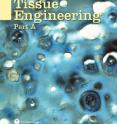Natural lung material is promising scaffold for engineering lung tissue using embryonic stem cells
The first successful report of using cell-depleted lung as a natural growth matrix for generating new rat lung from embryonic stem cells is presented in a breakthrough article in Tissue Engineering, Part A, a peer-reviewed journal published by Mary Ann Liebert, Inc. (www.liebertpub.com). The article is available free online at www.liebertpub.com/ten Embryonic stem cells (ESCs) have the potential to mature into virtually any type of cell and tissue type, but they require an appropriate environment and chemical signals to drive their differentiation into specific cell types and to form 3-dimensional tissue structures. Alternatives to available synthetic tissue matrices are needed to drive this technology forward and develop clinical applications for engineered lung tissue.
Joaquin Cortiella, MD, MPH, and colleagues from University of Texas Medical Branch (Galveston), Stanford University (Palo Alto, CA), Brown Medical School (Providence, RI), and Duke University (Durham, NC), describe the first attempt to make acellular rat lung and use it as a biological matrix for differentiating ESCs into lung tissue. The authors present evidence of improved cell retention, repopulation of the matrix, and differentiation into the cell types present in healthy lung. They also report signs that the cells are organizing into the 3-D structures characteristic of complex tissues and are producing the chemical signals and growth factors that guide lung tissue function and development.
Cortiella and coauthors describe the process used to remove the cellular component of natural lung tissue and create a growth matrix for ESCs in the article, "Influence of Acellular Natural Lung Matrix on Murine Embryonic Stem Cell Differentiation and Tissue Formation."
"Organ-specific extracellular matrices, properly prepared, are serving more and more as the appropriate structural scaffold for the recapitulation of a specific organ's tissues. This turns out to be especially true in an organ such as the lung, whose parenchyma must have a structure that accommodates atmospheric gas transmission as well as vascular, lymphatic, and neural systems," says Peter C. Johnson, MD, Co-Editor-in-Chief of Tissue Engineering and Vice President, Research and Development, Avery Dennison Medical Products.
Source: Mary Ann Liebert, Inc./Genetic Engineering News
Other sources
- Natural lung material is promising scaffold for engineering lung tissue using embryonic stem cellsfrom Science DailyFri, 20 Aug 2010, 3:21:12 UTC
- Natural lung material is promising scaffold for engineering lung tissue using embryonic stem cellsfrom Science BlogThu, 19 Aug 2010, 21:21:17 UTC
- Natural lung material is promising scaffold for engineering lung tissue using embryonic stem cellsfrom Science BlogThu, 19 Aug 2010, 21:21:16 UTC
- Natural lung material is promising scaffold for engineering lung tissue using embryonic stem cellsfrom PhysorgThu, 19 Aug 2010, 20:07:35 UTC
